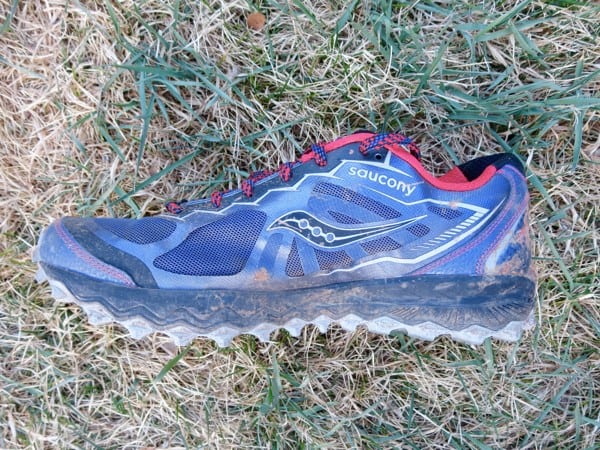For the latest on the Saucony Peregrine, check out our Saucony Peregrine 15 review.
Our Favorite Trail Running Shoes
Check out our Best Trail Running Shoes article to learn about our current favorite trail running shoes!
Saucony Peregrine 6 Review
For its five past versions, the Saucony Peregrine has been a mainstay on the feet of trail runners as one of the most popular shoes year after year. It has always been a shoe that seems to be able to handle 100 miles while also feeling nimble enough for any shorter distance. In fact, if you could only get one shoe for an entire season, the Peregrine has seemed a smart bet. All of the previous versions have essentially been small tweaks on the original design, which managed to get under the 10-ounce mark by continually improving the upper.
With the Saucony Peregrine 6 ($120), the company bravely creates design tweaks that actually add to the enjoyment of the shoe without losing the soul of the original. In previous years, I have visited my local running store to try on new versions of the Peregrine only to walk away unimpressed. The cushioning seemed uninspired, the fit was exceedingly narrow for an ultra-distance shoe, and Saucony didn’t seem to be pushing the design boundaries in any way beyond its original design. So with the Peregrine 6, we see the first major changes since 2011. Here I will attempt to highlight why and how I think these changes made a good trail running shoe even better.

The Saucony Peregrine 6.
Saucony Peregrine 6 Upper
The Peregrine 6 improves on its past uppers in two ways: it widens the toe box and decreases the use of unnecessary laminates. While I understand that this creates a somewhat less durable upper, it also gives my toes enough wiggle room and increases the breathability as well as drainage capabilities over past versions. I did experience some delaminating of welded-on overlays on the toe box on the medial side of one shoe, but I was the only person to experience this to my knowledge. In fact, with three other friends actively using this shoe as a daily trainer, I am the only one to experience any durability issues, so I’m considering this an epoxy fluke.
The fit through the midfoot continues to feel secure without having a sockliner or midsole wrap. Meanwhile, the heel cup gets a complete makeover and is stiffened significantly by the use of thermoplastic supports. This didn’t bother me, and in fact I didn’t notice this heel-cup redesign until inspecting the shoe after my first run. This may bother some truly neutral runners looking for a very flexible heel, but I think that Saucony employed this more rigid heel due to the softer cushioning provided by the combination of the softer outsole and EVERUN cushioning in the heel.
A nicely padded heel collar and tongue are unnecessarily complicated by the addition of braided and colorful flat laces which I will henceforth refer to as ‘friendship laces,’ as they look like an abomination your seventh-grade girlfriend gave you to get smelly around your wrist.

The Saucony Peregrine 6’s lateral upper and heel cup.
Saucony Peregrine 6 Midsole
In the heyday of the minimalist-shoe movement, the original Peregrine had a stack height of 18mm to 14mm. While this same weight and 4mm drop has been retained, the current stack height of the Peregrine 6 is 25mm to 21mm. Thanks to advances in EVA foam, Saucony adds 7mm of cushioning to this shoe without gaining weight, which I find simply amazing. This added cushioning is appreciated a great deal, and Saucony’s EVERUN EVA is actually made out of the exact same material as Adidas’s Boost, however it isn’t formed into pellets prior to being formed into sheets of EVA. With the EVERUN in the heel, I was worried that I would experience the same lack of forefoot cushioning which felt like torture during my second 50 miler back in 2011 in the Peregrine 2’s. However, Saucony used additional Saucony Super Lite EVA, which is what has been throughout past Peregrines, to make a well-balanced ride. The result is a soft heel with a firmer forefoot and an excellent transition.
Saucony employs a nylon-fiber rock plate as well as their External Bedrock Outsole for the usual amount of midsole protection from rocks. But, this protection is bolstered considerably by the outsole.

The Saucony Peregrine 6’s medial upper.
Saucony Peregrine 6 Outsole
This is where the most obvious changes take place in the new Peregrine. Saucony calls this new outsole PWRTRAC, and it is quite burly. The entire outsole is flared and features hexagonal lugs of various shapes about 5mm thick. Saucony claims that this rubber is stickier than what they’ve used in the past and I can attest to this. While sticky, it does wear fairly slowly and I can’t see wear yet despite approximately 100 miles. Unfortunately, this ‘iron throne’ looking outsole does not shed mud well at all due to the lack of spacing in the rather aggressive lugs. What these lugs are good at is climbing and descending, especially on terrain which may be loose and respond better to a beveled lug made of softer rubber. Also, runners who frequently scrape their trail legs on the opposite ankle or calf be warned. These beveled outsoles have given me several nice stingy scrapes on my calves and ankles. As long as your conditions don’t call for the constant shedding of mud and clay, I count the Peregrine 6’s outsole a winner.

The Saucony Peregrine 6’s outsole.
Saucony Peregrine 6 Overall Impressions
Out of the box the Peregrine 6 is a great trail shoe. If I still worked at a specialty-running store, this is a shoe that I could see being a customer favorite. While the addition of the Game of Thrones outsole may seem like too much, the increased cushioning and soft rubber continue the tradition of the Peregrine as a shoe that can handle all surfaces. For me, Saucony finally dialed in the fit by keeping the midsole snug but widening the forefoot, which will help with foot swelling in ultras. The more breathable upper was appreciated and I love that the Peregrine 6 dries within minutes of getting soaked. At 9.8 ounces for a well-cushioned and protective trail shoe, there isn’t much to dislike in the new Peregrine.
Call for Comments (from Meghan)
- Are you a Saucony Peregrine devotee? If so, what do you think of the 6 as compared to the previous iterations?
- With the design changes to the Peregrine 6 from previous editions, what changes do you like the most? What changes do you think could use some tweaking still?
- Other thoughts about the Saucony Peregrine 6? Leave a comment and share!
